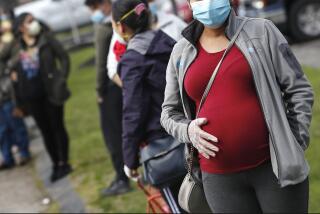Bizarre birth defect is on the rise, and researchers are baffled
- Share via
Physicians are seeing more instances of a birth defect in which infants are born with their intestines extruding from the stomach wall, with a particularly sharp rise among babies born to young African American mothers, according to the Centers for Disease Control and Prevention.
Over the 18 years leading up to 2012, the CDC has documented a 263% increase in the birth defect, called gastroschisis, among children born to black mothers under the age of 20, said a report released Thursday by the agency.
Coleen Boyle, director of the CDC’s National Center on Birth Defects and Developmental Disabilities, said it was urgent that researchers find the cause of the defect and determine which women are at greater risk for having babies with the affliction.
In gastroschisis, the intestines, and sometimes other visceral organs such as the liver and stomach, protrude through a hole next to a newborn’s bellybutton. Nearly 2,000 babies are born with the condition each year in the U.S.
Though the abnormality can be life-threatening, it is often surgically repaired soon after birth. But because the affected organs are irritated by their exposure to amniotic fluid inside a mother’s uterus, they can twist, swell, shorten and become infected.
As a result, babies born with the defect can have ongoing digestive and feeding problems. Some also have difficulty staying hydrated and absorbing nutrients from food, which can increase their risk of a range of medical problems, including stunted growth and malnutrition.
If the number of exposed internal organs is large, surgery must sometimes be done in stages. Recovery times can be long. Many babies born with the condition, which can be diagnosed during pregnancy by ultrasound, do not leave the hospital for six weeks or more, and their care in neonatal intensive units is costly.
The increased incidence of the defect has affected babies born to women across the spectrum of age and ethnicity. But most cases of gastroschisis occur in babies born to mothers younger than 20. The CDC said this fact was unchanged by a notable decline in births to teen mothers.
Although researchers do not know what causes gastroschisis, they suspect that environmental factors — a mother’s diet, medicines used during pregnancy or exposures to some toxin — may influence the development of a weak abdominal wall sometime early in pregnancy. What those harmful exposures might be, and whether babies born with the defect have some genetic vulnerability, remains a mystery.
CDC epidemiologist Suzanne Gilboa said a number of federally funded studies were tracking pregnant women and their babies “to dig into the ‘why’” of gastroschisis. Researchers have just a few clues to guide their hunt, she said: Mothers who consumed alcohol or used tobacco during pregnancy are at greater risk of having a baby with gastroschisis, as are women who had a sexually transmitted disease during pregnancy or who were underweight before pregnancy.
To discern the trend seen in the latest report, epidemiologists analyzed data from 14 states: Arizona, Arkansas, California, Colorado, Georgia, Iowa, Kentucky, New Mexico, New York, North Carolina, Oklahoma, Rhode Island, Texas and Utah. They compared rates of gastroschisis in the 1995-2005 period with rates seen during the 2006-12 period.
Follow me on Twitter @LATMelissaHealy and “like” Los Angeles Times Science & Health on Facebook.
MORE SCIENCE NEWS:
Astronomers’ findings point to a ninth planet, and it’s not Pluto
2015 was the hottest year on record, and the forecast for 2016 is warmer yet
Say cheese for science: Camera traps show how habitat protection aids biodiversity





